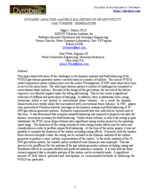Papers
“Dynamic Analysis And Field Balancing Of 100 MW Utility Gas Turbine – Generators,” |
Abstract
This paper deals with some of the challenges in the dynamic analysis and field balancing of the W501D gas turbine-generator system currently used in a number of utilities. The current W501D model represents a power enhancement over the earlier Westinghouse 70 MW units which have been in service for many years. The utility gas turbines present a number of challenges as compared to conventional steam turbines. Because of the design of the gas turbine, the hot end of the turbine requires a very flexible support under the tilting pad bearing. This in turn causes a significant reduction of stiffness and particularly of damping. In addition, there is substantial rotor-casing interaction which is not present in conventional steam turbines. As a result the dynamic characteristics are totally unlike that encountered with conventional steam turbines. In 1985, papers were presented at Vibration Institute meetings on the dynamic analysis and field balancing of 70 MW gas turbine-generator systems. Extensive experimental data was collected on various units at that time. It was determined that computer assisted balancing was required to properly calculate the balance corrections necessary for field balancing. Unlike steam turbines, in which the casing is quite substantial, the W501 series of gas turbines have significant casing motion present in the operating speed range. The dynamics of the casing introduces rotor-casing modes which must be taken into consideration in order to perform proper field balancing. At the time of the earlier papers, it was not possible to compute the dynamics of the system including casing effects. Currently, with the modern finite element computer codes, the casing can be included in the dynamic analysis of the turbinegenerator to produce a more realistic representation of the system. In the earlier analysis of the 70 MW gas turbine system, the transfer matrix method of rotor dynamics was employed. This has proven to be insufficient for the analysis of the gas turbine-generator systems including casing and foundation effects to compute stability and predicted unbalance response. It is only with the finite element approach that a complete analysis of the system can be accurately made. A significant amount of field data is presented and descriptions on recommended methods of balancing the W501D are presented.

